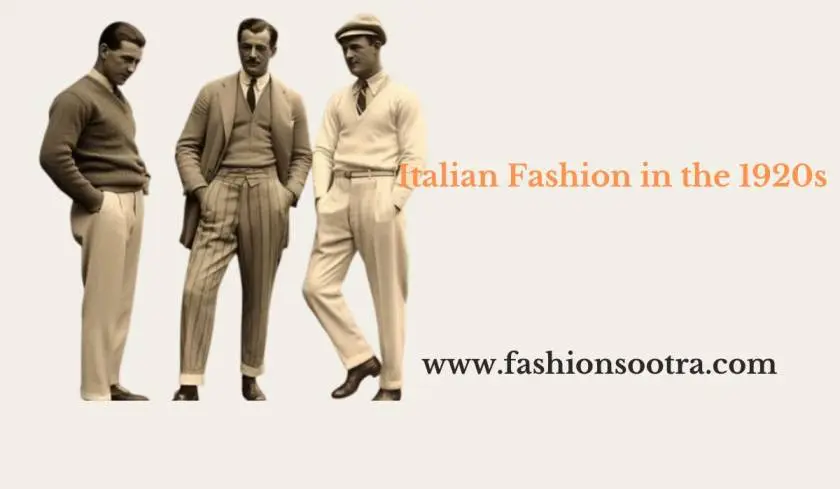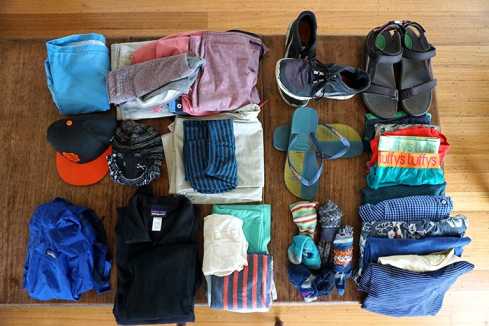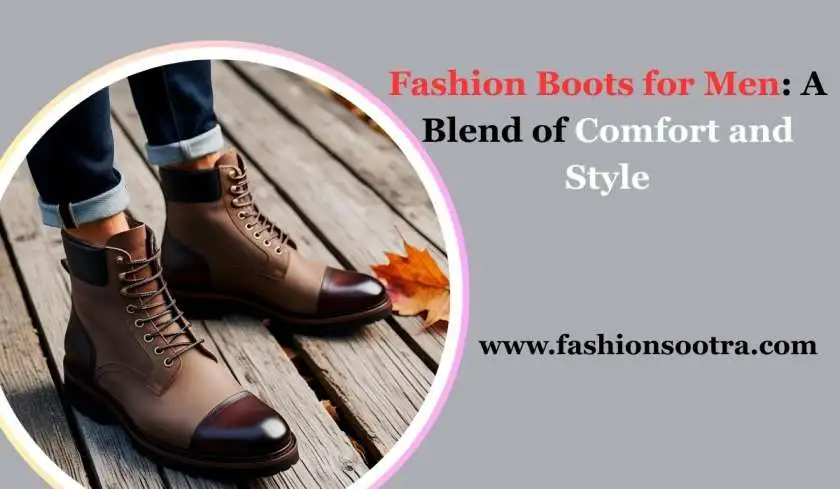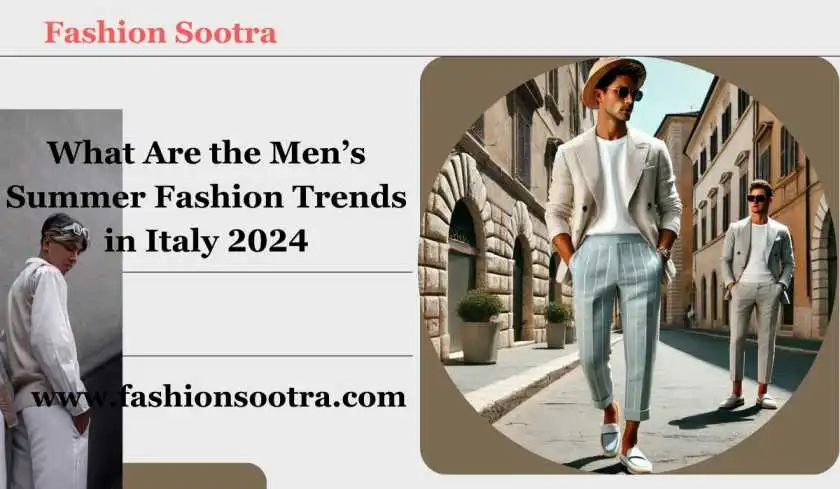When you want to know about Italian fashion in the 1920s. The world was all the while staggering from WWI. The contention, which finished a little more than a year prior to the new ten years starting, significantly affected society, culture, and design. Fundamental for these recent fads was a straightforwardness that had not recently been found in ladies' design. Dress antiquarian Jayne Shrimpton writes in Design during the 1920s:
This effortlessness made the well-known cylindrical "la garçonne" look that ruled a significant part of the ten years. Otherwise called the flapper, the look of Italian fashion in the 1920s was a dress with a dropped midriff and crawling hemlines that could be made in conservative textures.
Coco Chanel promoted this style and was a noticeable originator during the period. The two waistlines and hemlines followed comparative, however opposite, projections consistently, as waistlines dropped until 1923, preceding starting to rise again in 1928, while hemlines rose until 1926, when they began to fall once more.
What You Know Italian Fashion in the 1920s?

Evening dresses once in a while still almost arrived at the ground; however, a considerable lot of the well-known styles pursued the hemline directions of daywear, as exhibited in the distinction between a 1924 night dress and Italian fashion in the 1920s night dress like to now.
While straightforwardness in development was critical to both daywear and eveningwear, the last profited from resplendent design: beadwork, sequins, and weaving all made the glitzy evening time looks of the 10 years, similar to this yellow night dress made of silk and rhinestones.
Read Also: How to Dress Like a Fashionable Older Italian Man?
However, this was one of the more well-known styles; it was in no way, shape, or form as it were. Truth be told, a style promoted by Jeanne Lanvin couldn't be further from this "male/female" look. All things considered, these dresses had long, full skirts, at times even with panniers, similar to this dark and silver Robe de Style dress displayed here.
The History of Italian Fashion in the 1920s
They were female and heartfelt, similar to the pastel dress planned by Lanvin in 1922, embellished with a straw cap itself eliminated from the brimless cloche caps that were famous during the twenties. Lanvin's dresses were obviously not quite the same as the ill-defined outlines of the flapper; however, some deciphered this style with her own female contort.
One more pattern for ladies that delighted in monstrous fame in the twenties was that of athletic apparel worn as daywear. Athletic apparel had for some time been an OK type of easygoing wear for men; however, during the 1920s, it likewise became adequate for ladies.
The prevalence of active Italian fashion in the 1920s is frequently credited, in the same way as other of the most famous styles of the twenties, to Coco Chanel, yet fashioners, for example, Jane Regny and Jean Patou, additionally added to the athletic apparel pattern. Patou's yellow skirt and sweater set show how much tennis garments impacted the plan.

Tennis was the most well-known sport for ladies and accordingly the most famous motivation for design. For sure, one of the most well-known style stars of the mid-twenties was tennis star Suzanne Lenglen, whose short-sleeved, creased tennis dress and bandeau were made for her by Patou.
Her style, both on and off the court, roused the majority. Shrimpton composes, by the last part of the Italian fashion in the 1920s, taking cues from her and embracing more extensive style, sleeveless, knee-length, shift-like tennis dresses were trendy.
So well known were components of these active clothes that in a 1928 issue of The Tatler, M.E. Brooke composed, Active clothes have been created so much that they might go to lunch at the elegant eateries; actually they are frequently worn until the hour of mixed drink.
What Type of 1920 Italian Fashion Men's Like?
Italian Men fashion like formal dress. Design during the 1920s was about the entire look, and there were patterns in how the actual body was molded. The basic lines and gender-ambiguous states of style looked best on bodies liberated from bends.
Through exercise, diet, and different molding underpants, ladies endeavored to accomplish this look. Seeking the latest fashion trends and older Italian clothes during immigration.
The dawning look likewise worked with a mode for suntanned skin. Numerous ladies trim their hair into a sway, a famous hairdo that arose from the get-go in the 10 years.
Haircuts continued to get more limited, first with the shingle and afterward with the Eton crop, yet like hemlines, as the ten years attracted to a nearby, ladies were beginning to develop their hair longer once more. The cloche cap turned into a very famous embellishment that looked best with these short haircuts.
Read Also: Are Cargo Shorts Fashionable for Alt Clothing?
While the architects referenced above made and sold their styles, as did retail chains and such, the straightforwardness of the overarching mode all through the twenties made it simple for ladies, everything being equal, to reproduce those styles at home.
Key Elements 1920s Italian Fashion and Style Trends
This, joined with motivation taken from ordinary common young ladies' clothing and the utilization of materials, for example, pullover and counterfeit silk, prompted what has been considered a democratization of style during the Italian fashion in the 1920s.
Anybody could accomplish the popular look regardless of whether it implied the straightforward lines were made with a more affordable material and made at home as opposed to in an atelier.
This peculiarity is concentrated by style history specialists, but on the other hand, it was felt during the period. In her book Accomplishment Through Dress, The Hon. Mrs. C.W. Forester announced, Dress is currently no indication of economic well-being; as a matter of fact, rather the opposite.
Italian Older Men Fashion Clothes
As womenswear esteemed straightforwardness during the Italian fashion in the 1920s in this way, menswear did as well. Men created some distance from treated collars and formal tuxedos during the day. All things considered, they embraced delicate necklines and a couple of button suit coats frequently worn without a petticoat as found in the various styles displayed on the design plate.
Pinstripes were famous, as were English fleeces and English fittings. Martin Pel composes that English men were seen to be stylishly the most exquisite, and in vogue men expected to imitate the style and legacy of Savile Line and the English first class" (28). Well-known materials were tweeds and woolen clothes, contingent upon the season.
The main advancement in men's style happened in two special sorts of pants: the Oxford packs and the in addition to fours. Oxford packs filled in prominence around 1924-25 when students at Oxford embraced these wide-legged pants.

However, the beginning of the style is argumentative; it is by and large concurred that it got from the pants that rowers in Oxford's group groups pulled on over their shorts, and you can perceive how The Spectator caricaturized this in 1924.
The first style was around 22 inches wide at the last, a few inches more extensive than the typical men's pant leg. Oxford students started wearing these around the college, and soon the style spread.
What to Wear Italian Fashion in the 1920s?
As the style spread, so too did the width of the pant legs until at one point they came to up to 44 inches wide. The pants were made from wool and arrived in various varieties. They were generally worn by young people, maybe the male partners of the flappers, and turned into #1 of England's Splendid Youngsters, a gathering of well-off blue bloods known for their jokes in London's nightlife.
Related Article: Very Fashionable Older Italian Men With White Hair
The other improvement in menswear in the twenties was the addition of fours. Furthermore, fours were created out of normal pants short-legged pants that accumulate around the knee and like Oxford packs, were a piece baggier form of their forerunner.
They had an additional four creeps of material (subsequently the name), yet rather than broadening the pant leg, they actually secured it around the knee, and the additional material loomed over the band, making the loose look as seen at a racecourse in Italian fashion in the 1920s.
Frequently worn with a sweater, in addition to fours, were famous golf clothing, yet similar to how tenniswear crawled into easygoing womenswear, this style was likewise well-known daywear for men, as was tenniswear for men, as well. You can see the relaxed way men dressed to play tennis; however, some actually wore ties in 1920.
Fashion Icon: Edward, Prince of Wales
However, numerous men focused on England for the most part for their style motivation; one man stood out for his impact: Edward, Ruler of Grains. However, later a disputable figure, in the twenties, the Ruler of Ribs was the gorgeous, sharp-looking child of the lord who was frequently seen at parties in London. He had the standing of a playboy, yet he was likewise known for his design sense, and numerous men on the two sides of the Atlantic tried to dress like him.
However frequently shot in morning suits and tuxedos, he really loved the in addition to fours referenced above, frequently wearing them with argyle sweaters and socks both on and off the green. This representation from 1927 showed him in this clothing. He was the embodiment of the English style that men looked to during the Italian fashion in the 1920s.
Like womenswear, the look must be finished. Men, by and large, wore their hair short and covered with a cap: well-known styles incorporated the felt cap, the fedora or trilby, level covers, or the straw boater, relying upon the season and the man's status. Men created some distance from awkward ribbon-up boots and favored lower-cut oxfords or brogues (Shrimpton 33-34).
Jeanne Lanvin
Jeanne Lanvin is a French high fashion style originator who is the namesake behind the Lanvin mark. She started her profession by functioning as a milliner at the regret du Faubourg Holy person Honoré in Paris in 1889.
Lanvin planned wonderful apparel for her little girl Marguerite, and these plans were so respected by privileged ladies that they began requesting she make grown-up plans also. Her production of mother-and-little-girl plans ultimately prompted her making her own mark.
Lanvin is viewed as the world's most noteworthy style house yet keeps on creating high fashion. Lanvin cherished utilizing sensitive and costly textures to make her faultless plans. Wanton subtleties like beadwork, blossoms, ribbons, mirrors, and different embellishments were additionally included inside her rich manifestations.
Ethereal realm midsection dresses were a number one among her clients during the 1920s. She is maybe the most popular for making Robe de Style—a variety of chemise dress that included a full skirt and a dropped-midriff outline.
Elsa Schiaparelli
Elsa Schiaparelli is one more famous name in 1920s design. An Italian planner who was viewed as Coco Chanel's most prominent opponent, she was a self-educated fashionista with no conventional preparation in design making or dress development.
Despite the fact that she started her own attire name in the mid 1920s she was met with difficulties en route. It was only after 1927 that her plans became sufficiently famous to be highlighted Stylish magazine. Her plans would stay well known all through a greater part of the twentieth 100 years.
Her styles were to a great extent impacted by surrealists like Salvador Dalí and Jean Cocteau. In spite of no conventional training in style, Elsa Schiaparelli made a portion of the world's most great and famous plans.
Read Also: What Type of Clothing is Needed October in Italy?
The Wrap Dress - an exemplary ladies' piece of clothing that stays pertinent right up to the present day - was the brainchild of Schiaparelli, who was enlivened by how covers were tied. She likewise made a snappy soiree dress that was well known during the 1920s. Otherwise called a "Speakeasy Dress," it was an exquisite gown that contained a secret pocket so ladies could slip carafes into clubs during forbiddance.
Jean Patou
Jean Patou is a male style creator who moved to Paris in 1910 to turn into a couturier. Despite the fact that he opened up his most memorable store in 1912, he shut it not long after to act as a skipper in WWI. When he got back from fight, he resumed his couture house in 1919. During the 1920s, he became one of the most persuasive athletic apparel originators to at any point live.
As opposed to planning for popular flappers, Jean Patou intended for the "new lady" one who needed to look refined as she partook in sport. He is credited for concocting sewed swimwear as well as different things that stay predominant in ladies' athletic apparel.
At the point when he made a sleeveless and knee-length tennis outfit for popular female tennis star Suzanne Lenglen, the world was first acquainted with the tennis skirt, a piece of clothing that is as yet worn by female tennis players across the globe.
Madeleine Vionnet
Madeleine Vionnet is a French style originator who concentrated on in London prior to opening her most memorable design house in Paris in 1912. The Second Great War prompted a minor mishap, yet she would return her "Sanctuary of Design" in Paris in 1923 and would later extend to New York City in 1925.
She urged style to create some distance from solid, formal dress and on second thought embrace sleeker, gentler outlines. Albeit not too known as names like Coco Chanel, Madeleine Vionnet was exceptionally powerful during the Italian clothes during immigration in the world.
Alluded to as the "sovereign of the predisposition cut" and draftsman among dressmakers, she made sexy high fashion pieces that were a number one of style stars like Marlene Dietrich, Katharine Hepburn, Joan Crawford, and Greta Garbo. Her flawlessly planned Grecian style dresses promoted inclination cut plan among design architects across the globe.
Paul Poiret
Paul Poiret was an expert couturier, a main French style fashioner, and a pioneer behind a place of high fashion. He was well known for neoclassical manifestations and plans that were to some degree Oriental in impact.
His utilization of straight lines and rectangular themes made him an organizer behind what was thought of "current style," and numerous originators including the well known Elsa Schiaparelli thought of him as an extraordinary impact.
Read Also: Did Egyptians Use Scarab Shells in Jewelry?
His brilliant varieties and contemporary cuts were a much needed refresher to ladies who were becoming fed up with wearing prohibitive dress and tight-fitting undergarments.
Loosened up pieces of clothing like collection of mistresses pants, hung outfits, and realm midsection dresses were matched with kimono-style covers and turban caps. His adoration for realm midsection styles additionally expected bodices to be supplanted with underpants that all the more intently look like present day bras, which free the design universe of girdles totally.
Norman Hartnell
Norman Hartnell is a couture originator who rose to fame during the Italian fashion in the 1920s. A main English style originator, he was a most loved creator of the Regal Family for quite a long time.
He would proceed to turn into the Imperial Dressmaker to Sovereign Elizabeth in 1940 and Sovereign Elizabeth II in 1957. In the wake of opening a store in London in 1923, it wasn't well before his work got the attention of English debutantes and other predominant individuals from London society.
At that point, most top of the line style came from Paris. Norman Hartnell's well known marriage endlessly outfits for visitors to wear at society weddings demonstrated that London was likewise home to energizing, remarkable new style architects. Subsequent to planning for popular theater celebrities and screen entertainers, his far reaching and rich articles of clothing grabbed the eye of the regal family.
FAQ's- Italian Fashion in The 1920s
What fashion was popular in the 1920s?
The flapper style is the style a great many people consider when they consider 1920s design. Flapper ladies cleaved off their hair into a short, practically manly style. They wore short, baggy dresses. Enormous, extravagant, straw caps gave way to more modest caps, for example, cloches, a basic cap molded like the ringer of a window box.
What happened in Italy in the 1920s?
Fundamentalists drove by Piero Brandimarte killed eleven socialists and exchange unionists Turin on December 18-20, 1922. Ruler Victor Emmanuel III conceded State head Mussolini with crisis powers to reestablish request through December 31, 1923. Exactly 3,300 people were killed in political viciousness somewhere in the range of 1921 and 1923.
Why did Italians leave Italy in the 1920s?
Italian resettlement was powered by critical destitution. Life in Southern Italy, including the islands of Sicily and Sardinia, offered landless laborers minimal more than difficulty, double-dealing, and viciousness. Indeed, even the dirt was poor, yielding pretty much nothing, while hunger and infection were inescapable.
What did rich people wear in the 1920s?
Pinstripe suits were frequently worn as a feature of formal or business clothing and were viewed as an image of riches and achievement. Thus, the suit was promoted by money manager and brokers, and became related with the thriving economy of the 1920s.
How do you dress like a woman in the 1920s?
Ladies wore dresses the entire day, consistently. Day dresses had a drop midriff, which was a belt around the low midsection or hip and a skirt that hung anyplace from the lower leg on up to the knee, never above. Daywear had sleeves (long to mid-bicep) and a skirt that was straight, creased, hank stitch, or layered.







